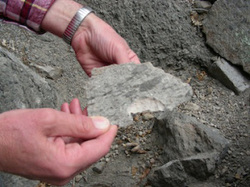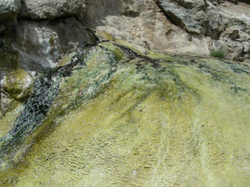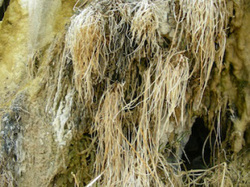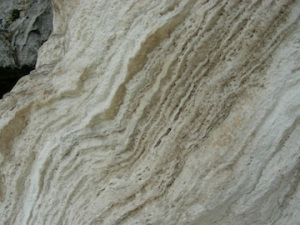
Guest post by Outspire guide Scott Renbarger.
Photo left:
Cliffs of white rhyolite tuff at Kashe-Katuwe Tent Rocks National Monument
Photo left:
Cliffs of white rhyolite tuff at Kashe-Katuwe Tent Rocks National Monument
 On the drive to Bandelier National Monument
On the drive to Bandelier National Monument Our visitors to Northern New Mexico aren’t here very long before they hear the “T” words tossed around. You arrange a visit to Bandelier National Monument and find yourself driving among the most unusual-colored cliffs you’ve ever seen:

When you get to the Monument the ranger tells you you’ve been driving through the Bandelier Tuff. Pretty soon you find yourself inside the stuff.
 The Soda Dam near Jemez Springs
The Soda Dam near Jemez Springs Or you make a road trip though the Valle Grande National Preserve, intending to stop at Los Ojos Saloon in Jemez Springs for one of their “Famous Jemez” Burgers, and get sidetracked looking at the Soda Dam right along the road outside of town:
 The Guaje Pumice along the road to Los Alamos
The Guaje Pumice along the road to Los Alamos This must be tufa, right? We just learned about tuff. Well, no, it’s technically travertine.
And why did they spray all that white concrete all over the rocks way out here?
Wait! The “High Desert Field Guide” I just bought says that’s a pumice deposit, and geologists call it tephra.
And why did they spray all that white concrete all over the rocks way out here?
Wait! The “High Desert Field Guide” I just bought says that’s a pumice deposit, and geologists call it tephra.
What a confusion of tongues! But as any student of the subject knows, the geological sciences are afflicted by a kind of logorrhoea when it comes to naming things. The geologist P. D. Krynine called stratigraphy “the complete triumph of terminology over facts and common sense”. And that’s just stratigraphy.
Most people instinctively know that each of these words probably has something to do with volcanoes, somehow, and of course they’re right. Tephra refers to any of the fragmental material a volcano ejects, regardless of the size of the fragments. This includes primary material like ‘bombs’, ‘cinders’, and ‘ash” as well as blocks of rock torn from the volcano’s cone or carried up from crust. As long as this fragmental stuff lies loosely in cones or drifts or layers on the ground, it is still called tephra.
Most people instinctively know that each of these words probably has something to do with volcanoes, somehow, and of course they’re right. Tephra refers to any of the fragmental material a volcano ejects, regardless of the size of the fragments. This includes primary material like ‘bombs’, ‘cinders’, and ‘ash” as well as blocks of rock torn from the volcano’s cone or carried up from crust. As long as this fragmental stuff lies loosely in cones or drifts or layers on the ground, it is still called tephra.
 Tephra in the El Cajete crater, Jemez Mountains
Tephra in the El Cajete crater, Jemez Mountains There have been eruptions of pumice – a sort of froth of natural volcanic glass – so recently in the Jemez Mountains that your can scoop up loose pumice out of the roadcuts with your hands:
Once this fragmental material consolidates into a more or less firm rock, it is called tuff. Some air-fall tephras are turned into rock – ‘lithified’ is the term geologists prefer, which means ‘turned into rock’ – by compaction and by ground water cementing the particles together. But most tuffs are formed almost immediately upon cooling, since the hot glassy fragments that make up the bulk of volcanic ash in pyroclastic flows are soft and hot enough to fuse together. This process is called welding. Depending upon the heat and size of the eruption and the proximity to the vent, a tuff can be welded weakly, or it can be fused together so firmly that you can scarcely distinguish it from lava.
Much of the Bandelier Tuff that visitors see on the way to Bandelier National Monument is only weakly welded, and once the weather-hardened rind is broken through, you can gouge out the tuff with simple tools. As you drive from Bandelier on into the Valles Caldera National Preserve, you might notice the tuff getting firmer and darker, breaking into hard plates of unmistakable rock.
Once this fragmental material consolidates into a more or less firm rock, it is called tuff. Some air-fall tephras are turned into rock – ‘lithified’ is the term geologists prefer, which means ‘turned into rock’ – by compaction and by ground water cementing the particles together. But most tuffs are formed almost immediately upon cooling, since the hot glassy fragments that make up the bulk of volcanic ash in pyroclastic flows are soft and hot enough to fuse together. This process is called welding. Depending upon the heat and size of the eruption and the proximity to the vent, a tuff can be welded weakly, or it can be fused together so firmly that you can scarcely distinguish it from lava.
Much of the Bandelier Tuff that visitors see on the way to Bandelier National Monument is only weakly welded, and once the weather-hardened rind is broken through, you can gouge out the tuff with simple tools. As you drive from Bandelier on into the Valles Caldera National Preserve, you might notice the tuff getting firmer and darker, breaking into hard plates of unmistakable rock.

A spectacular example of a welded tuff can be found within San Diego Canyon in the Jemez Mountains at Battleship Rock.
 Fiamme in the Battleship Rock Tuff
Fiamme in the Battleship Rock Tuff The only way to gouge out these rocks is with a jackhammer. This body of tuff was laid down by a very hot pyroclastic flow that surged down a canyon cut in the flank of the Valles Caldera very recently, geologically-speaking. In fact it records a catastrophic phase in the eruption that put down the El Cajete pumice we saw earlier. The flow of ash and pumice was so hot that the fragments of pumice were deformed into squashed and drawn-out tongues of rock, called fiamme (Italian for flames).
Firmly welded tuffs deposited from hot pyroclastic flows of ash are sometimes called ignimbrites. You really can’t help loving this word: “glowing cloud stone”.
Firmly welded tuffs deposited from hot pyroclastic flows of ash are sometimes called ignimbrites. You really can’t help loving this word: “glowing cloud stone”.
 Travertine forming at Soda Dam
Travertine forming at Soda Dam Travertine is calcium carbonate rock (“limestone”) deposited from a hot spring. Since the rock consolidates from material dissolved in hot water, rather than magma, it is technically a sedimentary rock. You can watch travertine forming right before your eyes at Soda Dam.
Heat generated from volcanic activity in the Jemez Mountains has set up a naturally circulating hydrothermal system that dissolves calcium carbonate from beds of limestone below the mountains, and then redeposits it at the surface where the hot water leaks out. The springs fizz with bubbles of carbon dioxide as the water depressurizes – hence the name Soda Dam – and this abrupt change in chemistry precipitates out the lime. This process is probably assisted by the algae that thrives in the hot water, accounting for the crusty, porous, almost baklava-like texture of the rock:
Heat generated from volcanic activity in the Jemez Mountains has set up a naturally circulating hydrothermal system that dissolves calcium carbonate from beds of limestone below the mountains, and then redeposits it at the surface where the hot water leaks out. The springs fizz with bubbles of carbon dioxide as the water depressurizes – hence the name Soda Dam – and this abrupt change in chemistry precipitates out the lime. This process is probably assisted by the algae that thrives in the hot water, accounting for the crusty, porous, almost baklava-like texture of the rock:
 Tufa-like deposits at Soda Dam
Tufa-like deposits at Soda Dam The only difference between tufa and travertine is the minor caveat that travertine is deposited from hot springs and tufa is deposited from springs at ambient temperatures. The only place I’ve seen tufa forming in Northern New Mexico is near Tunnel Springs in the Sandia Mountains near Albuquerque, where mineral-charged water seeping out of limestone beds is forming deposits of scaly lime, intimately mixed with sticks and leaf litter. Many “petrifying springs” are springs busy laying down tufa. Some of the cooler parts of Soda Dam mimic this, slowly fossilizing grass.
So there you have it.
So there you have it.


 RSS Feed
RSS Feed
